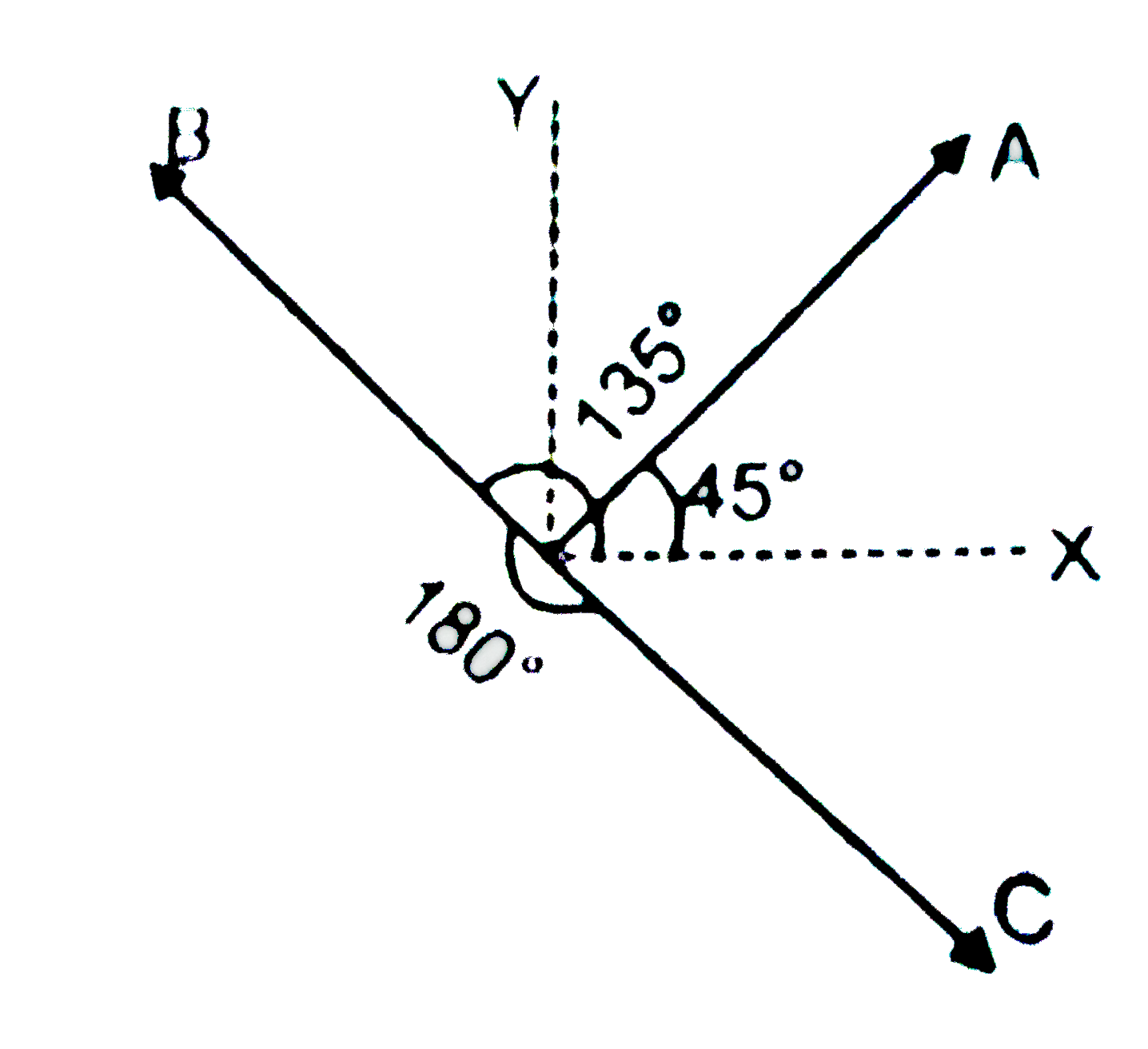Add vectors each having magnitude of 100 unit and inclined to the X-axis at angles respectively.
The correct Answer is:100 unit at with x axis
To solve the problem of adding vectors →A, →B, and →C with given magnitudes and angles, we will follow these steps:
Step 1: Determine the components of each vector
1. Vector →A:
- Magnitude: 100 units
- Angle: 45∘
- Components:
→Ax=100cos(45∘)=100⋅1√2=50√2
→Ay=100sin(45∘)=100⋅1√2=50√2
2. Vector →B:
- Magnitude: 100 units
- Angle: 135∘
- Components:
→Bx=100cos(135∘)=100⋅(−1√2)=−50√2
→By=100sin(135∘)=100⋅1√2=50√2
3. Vector →C:
- Magnitude: 100 units
- Angle: 315∘
- Components:
→Cx=100cos(315∘)=100⋅1√2=50√2
→Cy=100sin(315∘)=100⋅(−1√2)=−50√2
Step 2: Sum the components of the vectors
Now we will add the components of the three vectors:
- Total x-component:
Rx=→Ax+→Bx+→Cx=50√2−50√2+50√2=50√2
- Total y-component:
Ry=→Ay+→By+→Cy=50√2+50√2−50√2=50√2
Step 3: Calculate the magnitude of the resultant vector
The magnitude of the resultant vector →R can be calculated using the Pythagorean theorem:
R=√R2x+R2y=√(50√2)2+(50√2)2=√5000+5000=√10000=100
Step 4: Determine the direction of the resultant vector
The direction (angle θ) can be found using:
tan(θ)=RyRx=50√250√2=1
Thus,
θ=45∘
Final Result
The resultant vector →R has a magnitude of 100 units and is inclined at an angle of 45∘ to the x-axis.
---
- Magnitude: 100 units
- Angle: 45∘
- Components:
→Ax=100cos(45∘)=100⋅1√2=50√2
→Ay=100sin(45∘)=100⋅1√2=50√2
- Magnitude: 100 units
- Angle: 135∘
- Components:
→Bx=100cos(135∘)=100⋅(−1√2)=−50√2
→By=100sin(135∘)=100⋅1√2=50√2
- Magnitude: 100 units
- Angle: 315∘
- Components:
→Cx=100cos(315∘)=100⋅1√2=50√2
→Cy=100sin(315∘)=100⋅(−1√2)=−50√2
Rx=→Ax+→Bx+→Cx=50√2−50√2+50√2=50√2
Ry=→Ay+→By+→Cy=50√2+50√2−50√2=50√2
R=√R2x+R2y=√(50√2)2+(50√2)2=√5000+5000=√10000=100
tan(θ)=RyRx=50√250√2=1
Thus,
θ=45∘
Topper's Solved these Questions
- PHYSICS AND MATHEMATICSBOOK - HC VERMACHAPTER - PHYSICS AND MATHEMATICSEXERCISE - Objective 2
5 Videos
- NEWTON'S LAWS OF MOTIONBOOK - HC VERMACHAPTER - NEWTON'S LAWS OF MOTIONEXERCISE - Exercises
42 Videos
- REST AND MOTION : KINEMATICSBOOK - HC VERMACHAPTER - REST AND MOTION : KINEMATICSEXERCISE - Exercises
51 Videos
Similar Questions
Add vectors →A,→B and →C which have equal magnitude s of 50 unit and are inclined at angles of 45∘,135∘ and 315∘ respectively from x-axos.

View SolutionLet →Aand→B be the two vectors of magnitude 10 unit each. If they are inclined to the X-axis at angles 30∘and60∘ respectively, find the resultant.
View Solution
Knowledge Check
If →aand→b are unit vectors inclined to x-axis at angle 30∘and120∘ then ∣∣→a+→b∣∣ equals
A√2/3B√2C√3D2The vector sum of three vectors→A,→B and →C is zero . If ˆi and ˆj are the unit vectores in the vectors in the directions of →A and →B respectively , them :
A→C is in the plane of ˆi of ˆjB→C is along ˆi׈jC→C is along ˆiD→C is alongˆjA magnitude of vector →A,→B and →C are respectively 12,5 and 13 units and →A+→B=→C then the angle between →A and →B is
A0BπCπ/2Dπ/4
Two vectors (→a and →b) have equal magnitudes of 12 units. These vectors are making angles 30∘ and 120∘ with the x-axis respectively. Their sum is →r .Then the x and y components of r are
View SolutionThere vectors →a,→b and →c each have a magnitude of 50 m and lie in an xy plane. Their directions relative to the positive direction of the x axis are 30∘,195∘,and315∘, respectively. What are (a) the magnitude and (b) the angle of the vector →a+→b+→c, and (c ) the magnitude and (d) the angle of →a−→b−→c ? What are the (e) magnitude and (f) angle of a fourth vector →d such that (→a+→b)−(→c+→d)=0 ?
View SolutionThree vectors →A,→B and →C are such that →A=→B+→C and their magnitudes are in ratio 5:4:3 respectively. Find angle between vector →A and →C
View Solution→A,→B,→C,→D,→E and →Fare coplanar vectors having the same magnitude each of 10units and angle between successive vectors is 60∘
If →A,→B&→C is reversed the magnitude of resultant is
View SolutionThe magnitudes of vectors →A.→B and →C are respectively 12,5 and 13 unira and →A+→B=→C, then the angle between →A and →B is :
View Solution
